
Denali is the highest mountain peak in North America, with a summit elevation of 20,310 feet (6,190 m) above sea level. It is the tallest mountain in the world from base-to-peak on land, measuring 18,000 ft (5,500 m), with a topographic prominence of 20,194 feet (6,155 m) and a topographic isolation of 4,621.1 miles (7,436.9 km), Denali is the third most prominent and third-most isolated peak on Earth, after Mount Everest and Aconcagua. Located in the Alaska Range in the interior of the U.S. state of Alaska, Denali is the centerpiece of Denali National Park and Preserve.

Mount Foraker is a 17,400-foot (5,304 m) mountain in the central Alaska Range, in Denali National Park, 14 mi (23 km) southwest of Denali. It is the second highest peak in the Alaska Range, and the third highest peak in the United States. It rises almost directly above the standard base camp for Denali, on a fork of the Kahiltna Glacier also near Mount Hunter in the Alaska Range.

Mount Hunter or Begguya is a mountain in Denali National Park in Alaska. It is approximately eight miles (13 km) south of Denali, the highest peak in North America. "Begguya" means child in the Dena'ina language. Mount Hunter is the third-highest major peak in the Alaska Range.

Kahiltna Glacier is the longest glacier of the Alaska Range in the U.S. state of Alaska. It starts on the southwest slope of Denali near Kahiltna Pass. Its main channel runs almost due south between Mount Foraker to the west and Mount Hunter to the east. The name was first reported as "Car-ilt-nu Glacier" by Alaska Range explorer Lt. J.S. Herron in 1902. An alternate name is Kagheltnu Li'a. Kahiltna Glacier is the longest glacier in the Alaska Range at 44 miles (71 km) in length.

Talkeetna Air Taxi, established in 1947 as Talkeetna Air Service, is a Talkeetna, Alaska-based flight company. It operates wheel-ski equipped bush planes, and is one of less than a half-dozen air services with a permit to land in Denali National Park. Historically, business included supply runs to remote homesteads and prospecting claims—though in the past decade traffic has been primarily tourist and climber related.
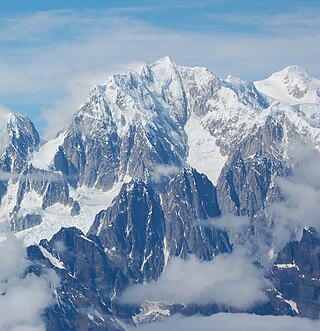
Mount Stevens is a mountain located in Matanuska-Susitna Borough, Alaska. Mount Stevens is flanked to the northwest by Mount Hunter, and is about 10 miles (16 km) south of Denali.
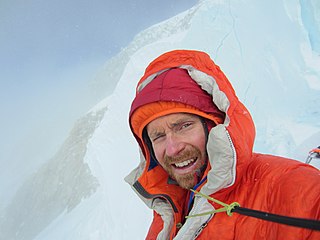
Colin Haley is an American alpinist known for fast ascents of technical routes on mountains around the world. Haley is perhaps best known for his traverse of The Torres, first with Rolando Garibotti in 2008, and subsequently with Alex Honnold - this time completing the traverse in under 24 hours.

Mount Johnson is an 8,400+ ft mountain summit located in the Alaska Range, in Denali National Park and Preserve, in Alaska, United States. It is situated on the west side of the Ruth Gorge, 15 miles (24 km) southeast of Denali and six miles (9.7 km) south-southwest of The Moose's Tooth. The nearest higher neighbor is Mount Wake, 0.69 miles (1.11 km) to the northwest.

Radio Control Tower is an 8,670 ft (2,640 m) elevation nunatak located in the Southeast Fork Kahiltna Glacier valley in the Alaska Range, in Denali National Park and Preserve, in the U.S. state of Alaska. It is situated west of the Kahiltna base camp for mountaineers attempting to climb Denali or Mount Hunter. Access to the area is via air taxi from Talkeetna. Radio Control Tower is set 7.86 mi (13 km) south of Denali, 2.17 mi (3 km) northwest of Mount Hunter, and 1.3 mi (2 km) southeast of Mount Frances.

Mount Barrille is a 7,650 ft (2,330 m) mountain summit located in the Alaska Range, in Denali National Park and Preserve, in the U.S. state of Alaska. It is situated 2,650 feet above the Ruth Glacier at the gateway to the Don Sheldon Amphitheater, or The Great Gorge, depending on direction of travel. Barrille is set 11.43 mi (18 km) southeast of Denali, 3.37 mi (5 km) west of The Mooses Tooth, 3.68 mi (6 km) east of The Rooster Comb, and 1.42 mi (2 km) north of Mount Dickey which is the nearest higher peak. The mountain was named by famed explorer Dr. Frederick Cook for Edward Barrill (1861–1946), a horse packer from Darby, Montana, who was his sole companion during his 1906 claim to be the first to climb Denali. The claim was later disproved, and in 1909 Barrill signed an affidavit stating that they had not reached the summit. Cook referred to his companion as Barrille in his accounts of the expedition, and Barrille remains as the official spelling used by the United States Geological Survey.

Mount Frances is a 10,450 ft (3,190 m) mountain summit located in the Kahiltna Glacier valley in the Alaska Range, in Denali National Park and Preserve, in the U.S. state of Alaska. It is situated north of the Kahiltna Glacier base camp for mountaineers attempting to climb Denali, Mount Foraker, or Mount Hunter. The summit of Mt. Frances is the best viewpoint from which to see all three giants from one location. Mount Frances is set 7.43 mi (12 km) southwest of Denali, 3.47 mi (6 km) northwest of Mount Hunter, and 1.3 mi (2 km) northwest of Radio Control Tower. Access to the area is via air taxi from Talkeetna. The mountain's name honors Frances Randall (1925-1984), the first Denali Base Camp manager for nine climbing seasons (1974-1983). She was planning a tenth season, but cancer claimed her life. Her expertise was instrumental in coordinating many rescues that saved lives and earned her the nicknames Guardian Angel of McKinley, and Kahiltna Queen. She was a member of the Fairbanks Symphony Orchestra, often playing the violin at base camp over the CB radio. In 1964 she became the sixth woman to reach the summit of Mount McKinley.
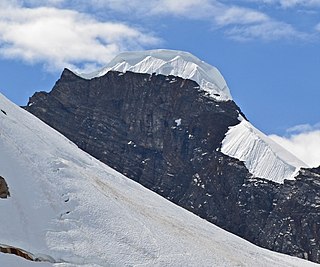
Pease Peak is a 7,750 ft (2,360 m) mountain summit located in the Alaska Range, in Denali National Park and Preserve, in the U.S. state of Alaska. It is situated 1,500 feet above the Tokositna Glacier to its west, and Ruth Glacier to the east, along the southern margin of the Don Sheldon Amphitheater, 11 mi (18 km) southeast of Denali, 2.84 mi (5 km) southeast of The Rooster Comb, and 0.45 mi (1 km) west of Mount Dickey, which is the nearest higher peak. Dickey forms the eastern buttress of Pittock Pass, whereas Pease forms the western buttress. Although overlooked as a climbing destination, the peak is often seen due to its proximity to the air taxi landing area and the Sheldon Chalet immediately north of the peak. Pease Peak, and its variant name Mount Pease, is based on a mountain climber's name that was published in the late 1940s.
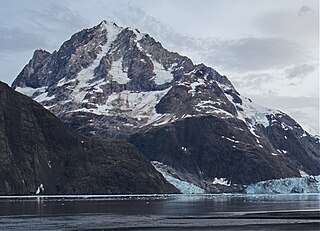
Mount Abbe is an 8200+ feet double summit mountain located in the Fairweather Range of the Saint Elias Mountains, in southeast Alaska. The peak is situated near the terminus of the Johns Hopkins Glacier, within Glacier Bay National Park and Preserve, 100 mi (161 km) northwest of Juneau, and 8.2 mi (13 km) northeast of Mount Orville. Although modest in elevation, relief is significant since the mountain rises up from tidewater in less than two miles. Mount Abbe is often seen and photographed with the Johns Hopkins Glacier, which is a popular destination for cruise ships. The mountain was named in 1936 by William Osgood Field and William Skinner Cooper, of the American Geographical Society, for Cleveland Abbe Jr., (1872-1934), an American geographer. Abbe received a Ph.D. in 1898 from Johns Hopkins University. The Gilman Glacier and Clark Glacier on the mountain's slopes were named for Daniel Coit Gilman, the institution's first president, and William Bullock Clark who was a professor of geology at the university. The mountain's name was officially adopted in 1937 by the United States Geological Survey. The first ascent of the south summit was made June 11, 1977, by Jim Wickwire and Dusan Jagersky via the Southeast Face. Three days later, Dusan Jagersky was killed while descending an unnamed peak. The first ascent of the north summit was made July 14, 1991, by Walter Gove and William Pilling. The months May through June offer the most favorable weather for climbing Mount Abbe, but it's a challenging climb in any conditions, with few attempts.
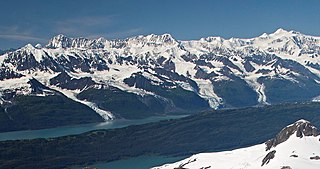
Mount Grace is a remote 10,540-foot (3,213 m) glaciated mountain summit located in the Chugach Mountains, in the U.S. state of Alaska. The unofficially named peak is situated 63 mi (101 km) east of Anchorage, 6 mi (10 km) north of College Fjord, 3.35 mi (5 km) east of Mount Goode, and 9.37 mi (15 km) southwest of Mount Marcus Baker, on land managed by Chugach National Forest.

Mount Grosvenor is an 8,400+ ft mountain summit located in the Alaska Range, in Denali National Park and Preserve, in Alaska, United States. It is situated on the west side of the Ruth Gorge, 0.87 mi (1 km) northwest of Mount Church and 0.54 mi (1 km) south of Mt. Johnson. Its nearest higher peak is Mount Wake, 1.32 miles (2.12 km) to the northwest. Despite its relatively low elevation, it is notable for its east face with over 4,000 feet of vertical sheer granite. The mountain was named by famed explorer Dr. Frederick Cook who claimed the first ascent of Denali in 1906, but was later disproved. This peak's unofficial name honors Gilbert Hovey Grosvenor (1875–1966), President of the National Geographic Society, father of photojournalism, and the first full-time editor of National Geographic magazine. The first ascent of the peak was made in 1979 by Gary Bocarde, Charlie Head, John Lee, and Jon Thomas.

On June 28, 2013, the centennial anniversary of the first ascent of Denali, Tom Choate was recognized as the oldest person to summit Denali at the age of seventy-eight years old. He has reached the peak of Denali multiple times, spanning across five different decades: in 1963, 1983, 1993, 2003, and lastly in 2013.
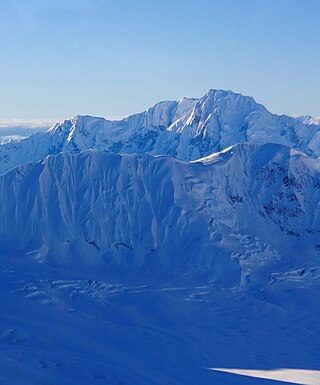
Mount Laurens is a 10,042-foot-elevation (3,061-meter) mountain summit in Alaska.

Royal Tower is an 8,130-foot-elevation (2,478-meter) mountain summit in Alaska.

Mount Gerdine is an 11,258-foot-elevation (3,431-meter) mountain summit in Alaska.

Mount Geist is a 10,716-foot-elevation (3,266-meter) mountain summit in Alaska, United States.


























